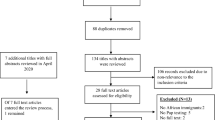Abstract
Understanding women’s psychological barriers to getting Papanicolaou (Pap) screening has potential to impact cancer disparities. This study examined pain perceptions of Pap testing among black, Latina, and Arab women and goal setting to receive Pap tests. Data on 420 women, in a longitudinal study, were analyzed using Chi-square tests of differences and generalized linear mixed models. At baseline, 30.3 % of black and 35.5 % of Latina women perceived Pap tests to be very painful compared to 24.2 % of Arab women. Perceptions of pain influenced goal settings, such as scheduling a first ever Pap test (odds ratio = 0.58, 95 % confidence interval 0.14–0.94). Immediately following the intervention, women’s perception that Pap tests are very painful significantly declined (P value <0.001) with Arab and black women registering the greatest improvements (20.3 and 17.3 % reduction, respectively, compared to 8.4 % for Latina). Having the perception that the Pap test is very painful significantly reduces the likelihood of black, Latina, and Arab women setting the goal to schedule their first ever Pap test. Latina women are the least likely to improve their perception that the Pap test is very painful, though national statistics show they have the highest rates of morbidity and mortality from cervical cancer. These findings are instructive for designing tailored interventions to break down psychological barriers to Pap screening among underserved women.

Similar content being viewed by others
References
Jemal A, Siegel R, Ward E et al (2008) Cancer statistics, 2008. CA Cancer J Clin 58:71–96. doi:10.3322/CA.2007.0010
Jemal A, Thun M, Ries L et al (2008) Annual report to the nation on the status of cancer, 1975–2005, featuring trends in lung cancer, tobacco use, and tobacco control. J Natl Cancer Inst 100(23):1672–1694
American Cancer Society (2011). Cancer Facts & Figures 2011. http://www.cancer.org/acs/groups/content/@epidemiologysurveilance/documents/document/acspc-029771.pdf
Agency for Healthcare Research and Quality. 2008. Cancer screening and treatment in women: recent findings. http://www.ahrq.gov/research/cancerwom.htm#intro
Hakama M, Miller AB, Day NE (eds) (1986) Screening for cancer of the uterine cervix: from the IARC working group on cervical cancer screening and the UICC project group on the evaluation of screening programmes for cancer. Oxford University Press, New York
Jemal A, Thomas A, Murray T et al (2002) Cancer statistics, 2002. CA Cancer J Clin 52:23–47. doi:10.3322/canjclin.52.1.23
Hoyo C, Yarnall KSH, Skinner CS et al (2005) Pain predicts non-adherence to pap smear screening among middle-aged African American women. Preventive Medicine 41:439–445
Morbidity and Mortality Weekly Report (MMWR). Cancer Screening—United States, 2010. Center for Disease Control and Prevention. December 2012, Retrieved from http://www.cdc.gov/mmwr/preview/mmwrhtml/mm6103a1.htm?s_cid=mm6103a1_w
Watson M, Saraiya M, Benard V et al (2008) Burden of cervical cancer in the United States, 1998–2003. Cancer 113:2855–2864. doi:10.1002/cncr.23756
National Cancer Institute (2009). SEER cancer statistics review 1975–2007. Bethesda, MD Retrieved from http://seer.cancer.gov
Jennings-Dozier K (1999) Predicting intentions to obtain a Pap smear among African American and Latina Women: Testing the theory of planned behavior. Nurs Res 48(4):198–205
de la Cruz GP, Brittingham A. The Arab population: census 2000 brief. December 2003, US Census Bureau
American Community Survey. 2008. Selected population characteristics & interactive map. Demographics data from the Arab American Institute. December 2012, Retrieved from http://www.aaiusa.org/pages/demographics/
Matin M, LeBaron S (2004) Attitudes toward cervical cancer screening among Muslim women: a pilot study. Women & Health 39(3):63–77
Salman K (2012) Health beliefs and practices related to cancer screening among Arab Muslim women in an urban community. Health Care for Women International 33(1):45–74
Michigan Department of Community Health and Michigan Public Health Institute. Special cancer behavioral risk factor survey, 2008. www.michigancancer.org/PDFs/MCCReports/SCBRFS_2008-042910.pdf.
Williams KP, Mullan PB, Todem D (2009) Moving from theory to practice: implementing the Kin KeeperSM Cancer Prevention model. Health Educ Res 24:343–56
Williams KP, Reiter P, Mabiso A, Maurer J, Paskett E (2009) Family History of cancer predicts Papanicolaou screening behavior for African American and White women. Cancer 115(1):179–189
Mandelblatt JS, Gold K, O'Malley AS et al (1999) Breast and Cervix cancer screening among multiethnic women: role of age, health, and source of care. Preventive Medicine 28(4):418–425
Harlan LC, Bernstein AB, Kessler LG (1991) Cervical cancer screening: who is not screened and why? Am J Public Health 81(7):885–890
Skrondal A, Rabe-Hesketh S (2009) Prediction in multilevel generalized linear models. Journal of the Royal Statistical Society, Series A 172:659–687
Skrondal A, Rabe-Hesketh S (2004) Generalized latent variable modeling: multilevel, longitudinal, and structural equation models. Chapman & Hall/CRC, Boca Raton, FL
Raudenbush SW, Bryk AS (2002) Hierarchical linear models: applications and data analysis methods, 2nd edn. Sage, Newbury Park, CA
SAS Institute Inc., 2008. SAS/STAT® 9.2 User's guide. Cary, NC: SAS Institute Inc.
Percac-Lima S, Aldrich LS, Gamba MA et al (2011) Barriers to follow-up of an abnormal Pap smear in Latina women referred for colposcopy. J Gen Intern Med 25(11):1198–1204
Acknowledgments
This project has been funded by the National Institutes of Health National Institute of Nursing Research R21NR010366. Each of the authors has contributed writing this manuscript and given their permission for their names to be used. We would like to thank Justice Wilson for formatting this manuscript.
Conflict of Interest
No financial disclosures were reported by the authors of this paper.
Author information
Authors and Affiliations
Corresponding author
Rights and permissions
About this article
Cite this article
Gauss, J.W., Mabiso, A. & Williams, K.P. Pap Screening Goals and Perceptions of Pain among Black, Latina, and Arab Women: Steps Toward Breaking down Psychological Barriers. J Canc Educ 28, 367–374 (2013). https://doi.org/10.1007/s13187-012-0441-1
Published:
Issue Date:
DOI: https://doi.org/10.1007/s13187-012-0441-1



